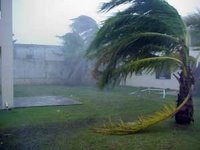
In September 2005, as Hurricane Rita raged to near-record fury in the Gulf of Mexico, scientists aboard a Navy plane achieved something remarkable: a close-up view of a mysterious process that allows killer storms to gain strength rapidly.
Their observations could lead to vastly more precise hurricane forecasts in several years. And so could the unusually detailed computer model that made the research possible, say the scientists, whose findings become public Friday in the journal Science.
"I'm an absolutely, unabashed admirer of this work," said Hugh Willoughby, a Florida International University hurricane researcher who wrote a commentary about the research for the same edition of the journal.
"It shows that hurricane modeling has matured to an extent that's really surprising." Willoughby said the study shows that hurricane models can be precise enough to aid costly decisions about when to close schools, evacuate barrier islands and shut down oil rigs - if the government will make the necessary computing power available.
"When a hurricane is coming, people always overreact - except when it really matters, and then they underreact," added Willoughby, a former director of the federal Hurricane Research Division in Miami. With better forecasts, "you can make good decisions, and you don't have to agonize over them."
The researchers running the study - based at the University of Washington, the University of Miami and the National Center for Atmospheric Research in Colorado - used the model and other high-tech imagery to direct the path of the plane as it circled Rita's eye.
That let them observe the storm at the precise time when it was shedding and replacing the band of intense winds and rain around the eye.
This change - known as the "eyewall replacement cycle" - occurs only in major hurricanes. It often signals sudden, terrifying surges in intensity, such as the one Hurricane Charley underwent in the hours before it tore into Southwest Florida as a Category 4 storm in August 2004.
Better understanding of the cycle could allow meteorologists to predict when these changes will occur, said Robert Houze, the University of Washington researcher who led the team. Never before have scientists gotten such a close view of the process, he added.
"It's very exciting that the model was able to predict and simulate the way that Rita evolved and developed an eyewall replacement," Houze said. "We could only do this with a high-resolution model."
The model used in the study, known by the cryptic name MM5, is hardly new - it has been around in various versions for decades. But the University of Miami researchers ran it at unusually high resolution, so that it could pinpoint features of the atmosphere about a mile across.
That's far more precise than what federal forecasters typically use for the models that guide the National Hurricane Center's forecasts.
"With a very coarse net, you can only catch big fish," said paper co-author Shuyi Chen, an associate professor of meteorology and physical oceanography at the University of Miami. "You have to have a very fine mesh in your computer model to actually see the eye and the eyewall."
The downside: It takes more computing power to run the models at higher resolution. On top of that, the government's hurricane models must run every six hours during a storm, and must compete with numerous other weather and climate models that the National Oceanic and Atmospheric Administration operates.
NOAA is debuting a new state-of-the-art hurricane model this coming season, but it will start out with a grid about five times wider than the one the Miami researchers used, said Frank Marks, director of the federal Hurricane Research Division in Miami. NOAA is aiming for higher resolutions, "but I don't think we're there yet," he said.
During the time the researchers were studying it, Rita became the fourth most intense Atlantic hurricane on record, with sustained wind speeds peaking at 178 mph. (Hurricane Katrina, which killed more than 1,300 people in Louisiana and Mississippi a month earlier, ranks No. 6 in intensity.)
Rita weakened to a 115 mph, Category 3 storm by the time it made landfall near the Texas-Louisiana border. It directly killed seven people in the United States while causing one of the largest evacuations in the nation's history, sending an estimated 2 million people fleeing from the Texas Gulf Coast.
Dozens more died during the evacuation, including 23 nursing home patients whose bus exploded near Dallas.
Houze said the scientists planned the expeditions three years in advance, not knowing that August and September 2005 would produce some of the fiercest hurricanes ever recorded.
"We were lucky," he said.
 Tropical Storm Noel strengthened as it began to head toward Florida and the Bahamas on Wednesday after drenching Cuba and killing at least 61 people with surging floodwaters and mudslides in the Dominican Republic and Haiti.
Tropical Storm Noel strengthened as it began to head toward Florida and the Bahamas on Wednesday after drenching Cuba and killing at least 61 people with surging floodwaters and mudslides in the Dominican Republic and Haiti.







